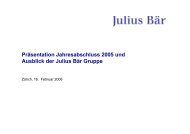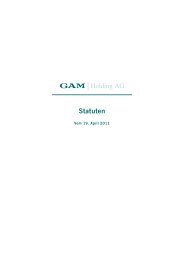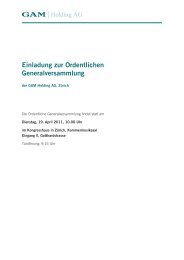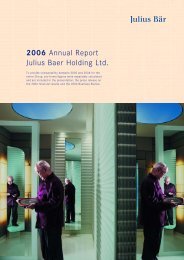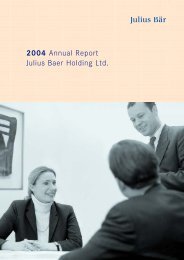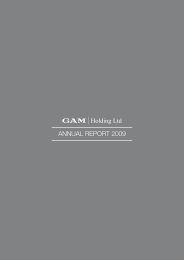2005 Annual Report Julius Baer Holding Ltd. - GAM Holding AG
2005 Annual Report Julius Baer Holding Ltd. - GAM Holding AG
2005 Annual Report Julius Baer Holding Ltd. - GAM Holding AG
You also want an ePaper? Increase the reach of your titles
YUMPU automatically turns print PDFs into web optimized ePapers that Google loves.
A hedge is regarded as highly effective if actual<br />
results are within a range of 80% to 125%.<br />
Changes in the fair value of derivatives that are designated<br />
and qualify as fair value hedges and that<br />
prove to be highly effective in relation to hedged risk<br />
are recorded in the income statement, along with the<br />
corresponding change in the fair value of the hedged<br />
asset or liability that is attributable to that specific<br />
hedged risk.<br />
If the hedge no longer meets the criteria for hedge<br />
accounting, in the case of interest-bearing financial<br />
instruments the difference between the carrying<br />
amount of the hedged position at that time and the<br />
value that this position would have exhibited without<br />
hedging is amortized to net profit or loss over the<br />
remaining period to maturity of the original hedge. In<br />
the case of non-interest-bearing financial instruments,<br />
on the other hand, this difference is immediately<br />
recorded in the income statement.<br />
Changes in the fair value of derivatives that have<br />
been recorded as a cash flow hedge, that fulfill the<br />
criteria mentioned above and that prove to be effective<br />
in hedging risk are reported under the item<br />
Reserves IAS 39 in shareholders’ equity. If a future<br />
financial transaction or an obligation results in a balance<br />
sheet item, the gains or losses previously<br />
recorded in shareholder’s equity are derecognized<br />
and set off against the cost of this balance sheet<br />
item. If the hedged cash flow or the obligation leads<br />
to direct recognition in the income statement, the<br />
hedging instrument’s cumulative gains or losses from<br />
previous periods in shareholders’ equity are included<br />
in the income statement in the same period as the<br />
hedged transaction.<br />
Certain derivative transactions represent financial<br />
hedging transactions and are in line with the risk<br />
management principles of the Group. However, in<br />
view of the strict and specific guidelines of IFRS, they<br />
do not fulfill the criteria to be treated as hedging<br />
Notes<br />
transactions for accounting purposes. They are therefore<br />
reported as trading positions. Changes in value<br />
are recorded in the income statement in the corresponding<br />
period.<br />
The fair values of derivative instruments held for trading<br />
and hedging purposes are disclosed in Note 29.<br />
Financial investments<br />
Security positions acquired with long-term investment<br />
objective are reported under this item.<br />
In accordance with IAS 39, there are two categories<br />
of financial investments:<br />
1. Debt securities categorized as “held-to-maturity”<br />
are initially recorded at cost and subsequently<br />
stated at amortized cost in the balance sheet. The<br />
effective interest rate method is used to amortize<br />
the difference between the cost and the repayment<br />
value over the life of the securities.<br />
A held-to-maturity financial investment is deemed<br />
impaired if it is likely that the amount due according<br />
to the contractual terms cannot be entirely<br />
collected. The reasons for impairment are specific<br />
to the relevant counterparties or countries. When<br />
impairment occurs, the corresponding reduction<br />
in the carrying amount to the recoverable amount<br />
is recognized in the income statement.<br />
Interest is accrued in the period incurred using<br />
the effective interest rate method and recognized<br />
in the item net interest income.<br />
2. Available-for-sale debt securities are stated at fair<br />
value. Unrealized gains and losses are reported<br />
under the item Reserves IAS 39 in shareholders’<br />
equity until the financial asset is sold, or until a<br />
drop in value is recognized, at which point the<br />
cumulative gain or loss previously recorded in<br />
shareholders’ equity is recognized in the income<br />
statement under the item other ordinary results.<br />
JULIUS BAER GROUP 73





